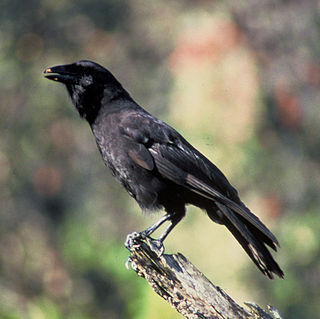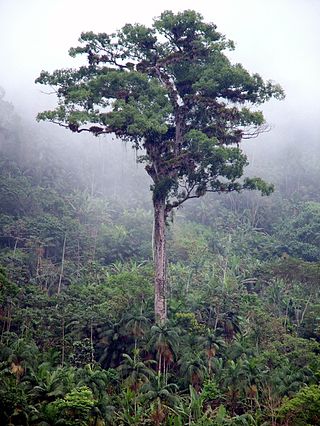
The International Union for Conservation of Nature (IUCN) Red List of Threatened Species, also known as the IUCN Red List or Red Data Book, founded in 1964, is an inventory of the global conservation status and extinction risk of biological species. A series of Regional Red Lists, which assess the risk of extinction to species within a political management unit, are also produced by countries and organizations.

The macaques constitute a genus (Macaca) of gregarious Old World monkeys of the subfamily Cercopithecinae. The 23 species of macaques inhabit ranges throughout Asia, North Africa, and Europe. Macaques are principally frugivorous, although their diet also includes seeds, leaves, flowers, and tree bark. Some species such as the long-tailed macaque will supplement their diets with small amounts of meat from shellfish, insects, and small mammals. On average, a southern pig-tailed macaque in Malaysia eats about 70 large rats each year. All macaque social groups are arranged around dominant matriarchs.

A genet is a member of the genus Genetta, which consists of 17 species of small African carnivorans. The common genet is the only genet present in Europe and occurs in the Iberian Peninsula, Italy and France.
Woodburnia penduliflora is a species of flowering plant in the family Araliaceae and the only representative of the genus Woodburnia. It is endemic to Burma and was first described from the Kachin State in 1903. The genus was named after the former president of the Asiatic Society of Bengal and lieutenant governor of Bengal, John Woodburn. It was described by botanist David Prain as having striking flowers unusually large for the Araliaceae family.

A species that is extinct in the wild (EW) is one that has been categorized by the International Union for Conservation of Nature as only consisting of living members kept in captivity or as a naturalized population outside its historic range. Classification requires exhaustive surveys conducted within the species' known habitat with consideration given to seasonality, time of day, and life cycle. Once a species is classified as EW, the only way for it to be downgraded is through reintroduction.
Crudia penduliflora is a species of plant in the family Fabaceae. It is a tree endemic to Peninsular Malaysia. It is threatened by habitat loss.
Cariniana ianeirensis is a species of woody plant in the family Lecythidaceae. It is found only in Brazil. It is threatened by habitat loss.

Cariniana is a genus of trees in the family Lecythidaceae, first described as a genus in 1842. The entire genus is native to South America. Many are of importance for timber production. Species of this genus may be known commonly as jequitibá.
Allantoma integrifolia, synonym Cariniana integrifolia, is a species of woody plant in the Lecythidaceae family. It is found only in Brazil. It is threatened by habitat loss.
Allantoma kuhlmannii, synonym Cariniana kuhlmannii, is a species of woody plant in the Lecythidaceae family. It is found only in Brazil. It is threatened by habitat loss.

Cariniana legalis is a species of emergent rainforest tree in the Monkeypot family Lecythidaceae. It is found in the Atlantic forest of south-eastern Brazil, where is known as jequitibá-branco or jequitibá-rosa, and possibly found in Colombia, and Venezuela. These trees can be very large. A C. legalis measured by botanical explorer David Fairchild was 62 feet in circumference with no buttresses at six feet above ground.
Allantoma pauciramosa, synonym Cariniana pauciramosa, is a species of flowering plant in the family Lecythidaceae. It is endemic to Brazil. It has only been collected once, in the rainforests in the state of Amazonas.

Cariniana pyriformis is a species of woody plant in the family Lecythidaceae. It is found in Brazil, Colombia, Costa Rica, and Venezuela. It is threatened by habitat loss.
Allantoma uaupensis, synonym Cariniana uaupensis, is a species of woody plant in the Lecythidaceae family. It is found only in Brazil. It is threatened by habitat loss.
Leucas penduliflora is a species of flowering plant in the family Lamiaceae. It is found only in Yemen. Its natural habitat is subtropical or tropical dry shrubland.
Aoranthe penduliflora is a species of flowering plant in the family Rubiaceae. It is endemic to Tanzania where it is found in the Usambara Mountains. It is threatened by habitat loss caused by logging, mining, and agriculture. It grows as a tree with simple, opposite leaves. The flowers are cream and red, and the fruit ripens orange.
Chalybea penduliflora is a species of plant in the family Melastomataceae. It is endemic to Caquetá, and Huila in Colombia.
Mimusops penduliflora is a species of plant in the family Sapotaceae. It is endemic to Tanzania.

A vulnerable species is a species which has been categorized by the International Union for Conservation of Nature as being threatened with extinction unless the circumstances that are threatening its survival and reproduction improve.

Endangered species, as classified by the International Union for Conservation of Nature (IUCN), are species which have been categorized as very likely to become extinct in their known native ranges in the near future. On the IUCN Red List, endangered is the second-most severe conservation status for wild populations in the IUCN's schema after critically endangered. In 2012, the IUCN Red List featured 3,079 animal and 2,655 plant species as endangered worldwide. The figures for 1998 were 1,102 and 1,197 respectively.








